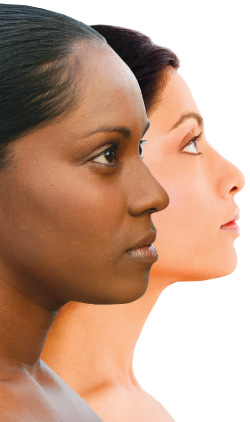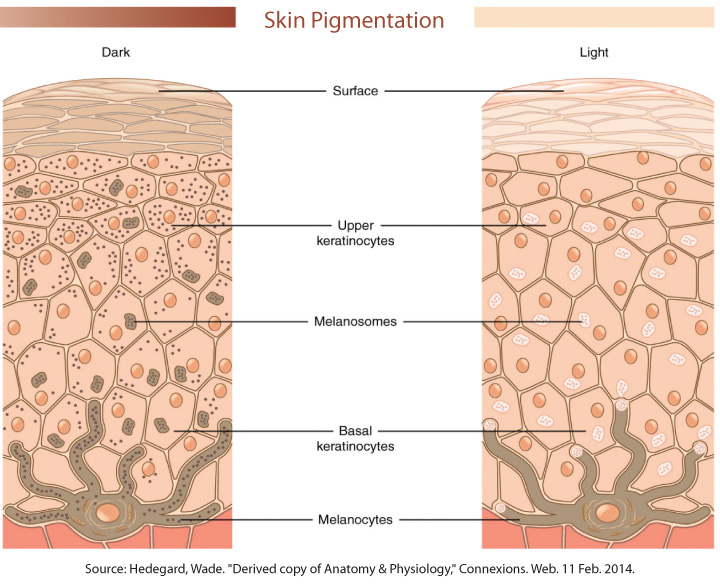People with skin of color will soon make up the majority of the United States. This will have a significant impact on the practice of professional skin care. Generally, lighter shades of skin have been the dominant skin type in the United States. This is the skin type that the majority of skin care treatments are currently based on. However, these traditional facial, body, and skin care treatments often fail to meet the needs of your clientele who has dramatically changed over the last decade. Darker skin responds differently to chemical and manual therapies than lighter skin. Aestheticians must understand these differences. Inappropriate treatments or products are a recipe for skin disaster; therefore, it is imperative for the skin care professional to understand the physiology, anatomy, and histology relating to all skins of color.
 Variations in Skin Color
Variations in Skin Color
Look at the rainbow of skin colors that make up the millions of skin types and where they originate. There is enormous variability in skin pigmentation, especially among distinct racial and ethnic groups, making it difficult to define skin types simply by ethnicity, race or culture. Individuals with darker skin comprise a wide range of racial and ethnic groups, including Africans, African American, African Caribbean, Japanese, Chinese, Asians, Latinos, Indians, Jewish and Pakistanis, to name a few. In the last several years, demographics shifted with respect to the predominate Caucasian skin types treated and are juxtaposed with like-kinds that can appear light, only to have genetic ties to infinite blends of many racial combinations.
Many of our clients are from multicultural backgrounds, so it is important to conduct a client interview along with Fitzpatrick’s traditional classification before you begin treatment. After determining skin type, all aestheticians must understand what is appropriate and inappropriate concerning skin treatments and products for all ethnic types.
Cosmetically speaking, skin has a wide range of color variations. Darker skin tones from a creamy light coffee color to deep ebony black. Medium-toned skin can have the appearance from a light yellow hue to a dark golden tan or range from light to dark red brown. Light skin ranges greatly from milky alabaster white to olive tones. Every person’s skin has its own unique skin DNA imprint response with respect to sensitivity, pigmentation, healing, scarring, erythema, edema, et cetera.
The color of skin evokes a multitude of emotions and personal interactions from society. In the context of skin care, it is important to distinguish between race and ethnicity. Race is a geographical distinction. As a basis for racial categorizations, humans have been divided into five geographical groups that include Caucasian, Mongoloid, Australoid, Negroid, and Capoid. Ethnicity is defined and based on origin and phenotypic pigmentation aestheticians require on a comprehensive understanding of these structural differences in the skin. Phenotypic pigmentation, or skin type, is what is important for treatment purposes.
It is important to determine your client’s skin type before considering treatment options. Fundamental structural and functional differences exist between darker and lighter skin. Because of these differences, a treatment that works well for one skin type can be damaging to another.
Skin of color is defined as the non-Caucasian skin types by Fitzpatrick’s traditional classification, or as we now know in the 21st Century as skin protection type (SPT), comprised of skin protection types III through VI.
Anatomy of Skin Color
Melanocytes, melanin, and pigmentation formulate the key color distinction of skin. The content of melanin within keratinocytes determines skin color, with deeply pigmented skin having the highest content of epidermal melanin.
Melanin is a complex molecule responsible for the pigment in the skin, hair, and eyes. This molecule protects skin by reducing the penetration of ultraviolet rays into the skin and, subsequently, into the nuclei of cells where DNA resides. It is important to note that both dark skin and light skin have the same number of melanocytes, cells responsible for melanin production or melanogenesis; however, the cells respond differently in the various skin types. It is important to understand the difference of melanocyte mechanics between light and dark skin colors.

In humans, the melanocyte system consists of two anatomically and physiologically distinct branches: the basal layer of the epidermis and the hair bulbs, which is responsible for the pigmentation of hair. Epidermal melanocytes vary in size and shape according to their population density. In an area of skin where there are few melanocytes, they have longer dendrites; in the population of many melancytes, dendrites are shorter.
The intensity of visible pigmentation is not solely determined by the pigmentary activity of the melanocytes, but also by the rate of transfer and mode of distribution of melanosomes within the keratinocyte population. Once inside the epidermal cells, the melanin granules tend to shift to the upper part that faces the outside, arranging themselves in the form of a cupola above the cell nucleus. The number, type, size, and distribution patterns of melanosomes in epidermal tissues are genetically controlled. Melanosomes in darker skin are larger than those in lighter skin. When inside the keratinocytes, the large melanosomes in darker skin of color types remain intact, but the clumps of melanosomes in lighter skin become attached to lysosomes (membrane bound organelle in the cell containing digestive enzymes) and are eventually disrupted, leaving a melanin dust.
The amount of melanin is the basis of skin typing classification. Use of an uptake skin history form for ultraviolet radiation (UVR) reaction is an important part of skin assessment. The higher epidermal melanin content in darker skin provides greater intrinsic photo protection. Simply put, higher melanin concentration translates into a better photo protection from ultraviolet radiation, delaying the clinical appearance of photo aging brought on by photo damage, especially in lighter skin types who are more prone to ultraviolet burn.
In contrast, melanocyte response to epidermal and superficial dermal tissue injuries is more severe with the potential of permanent or long lasting injury and difficult-to-treat pigment morbidity. The consequences of dermal tissue damage causing aging changes and pigmentation in darker skin requires greater care and appropriate ingredient product selection.
To fully understand melanin and its influence in skin, you have to acknowledge the biologic differences in melanocytes. Melanocytes are dendritic cells (cells with extended arms) located in the basal layer of the epidermis. There are approximately 36 keratinocytes interfacing with one melanocyte, forming what is identified as the epidermal-
melanin unit. Distribution of these cells can vary and when isolating facial regions, more numerous melanocytes are found on the head and neck.

Aside from pigmentation, the variability within each ethnicity differentiates skin of color. Research provided on racial and ethnic differences in skin and hair structure, physiology and function may only involve small populations and have methodological flaws, leaving few definitive answers. This information deficiency could account, in part, for the lower incidence of reported cancers, differences in photo-aging and pigmentary morbidity in skin of color, in comparison to individuals with a lighter skin type and a higher reported incidence of certain types of alopecia in Africans and African Americans, compared with those of a different ancestry. Professional skin care technicians, whether in the medical, cosmetic or skin care field, are at times perplexed regarding the differences and how to approach prudent treatment.
 Pigmentation Conditions
Pigmentation Conditions
An important cosmetic pigmentation issue is pregnancy-induced hypertension (PIH). Pregnancy induced hypertension is characterized by an acquired increase in cutaneous pigmentation, secondary to an inflammatory process. Excess pigment deposition may occur in the epidermis or in both epidermis and dermis. This condition occurs in skin types with a higher incident rate in individuals with darker skin.
Another pigment challenge is known as solar lentigos, which are is characterized by light brown to brown lesions occurring as discrete hyperpigmented macules on sun-
exposed areas of the skin that include the face, arms, chest, and back. This pigmentation condition is characterized by elongated rete ridges, club-shaped extensions, and a proliferation of melanocytes and keratinocytes. Common in skin of color types IV, this condition is less common in darker skin.
The increased thickness of skin associated with darker skin types appears to be primarily due to amplified dermal thickness and amounts of collagen present. Combine this with enhanced melanin photo protection and the result will be a delay of clinical wrinkle appearance associated with actinic damage, typically associated with lighter skins. This also results in a tighter skin appearance.
Reactions to Non-Invasive Treatments by Skin Type
Dr. Randall Wickett, chairman of the International Society for Bioengineering and the Skin, co-conducted an investigation comparing different Fitzpatrick skin types, using non-invasive methods. The comparison between light-skinned Caucasians and relatively dark-skinned African Americans found slightly higher transepidermal water loss (TEWL) and skin pH values in Caucasian subjects. Transepidermal water loss remains the most studied biophysical property in defining differences between various skin types. In dark skin, this water loss is 1.1 times greater than in light skin. PH regulates homeostasis in epidermal permeability and is similar in all skin tones.
Irritant Reactions
Researchers have identified differences in irritant reaction provoked by the topical application and occlusion of sodium lauryl sulfate in different skin types. This common detergent is used in many skin care cleansers and other personal products such as toothpaste. Check your cleansers for this ingredient irritant and avoid it, as it is
also comedogenic.
Based on this study, several conclusive findings are noted. While the higher concentration of sodium lauryl sulfate caused a significant increase in cutaneous blood flow in all groups:
- Dark skin is more sensitive to irritants and displays a stronger skin irritant reaction than lighter skin.
- Dark skin displays less erythema, less blood vessel reactivity and less cutaneous blood flow to irritants than lighter or mediumtoned skin.
- Medium-toned skin, similar to dark skin, shows a stronger irritant reaction compared to light skin.
- Medium-toned skin has stronger irritant reactions, when injured, with concentrated chemicals.
- Medium-toned and light skin have similar erythematous reactions manual.
 Treatments for Skin of Color
Treatments for Skin of Color
Dark skin also exhibited higher grades for skin dryness, which could be due to lower ceramide levels in the stratum corneum (SC). Flaking skin is especially easy to see on darker skin types and generally casts a gray appearance, which indicates non-nucleated attached desquamated cells.
Protease Peels
Protease peels are excellent in helping to gently manage this dry, flaky condition. Protease plays a major key role in tissue remodeling process, lipid barrier homeostasis, and inflammation reduction, making it the perfect constituent for acne, sun damaged, pigmentation and aging skin. Professional solutions for best end point results is a 30 percent protease peel because it is gentle and works on one cell at a time, releasing the desmosomes and corneodesmosomes to induce the detachment of the squames at the outer layer of the epidermis at a rate uniquely balanced by mitotic development of new cells at the basal layer. The key event that eventually results in the orderly desquamation of old, worn out and injured skin cells are the proteolysis of the corneodesmosomal proteins.
Tyrosinase Inhibitors
If you are treating skin of color, using any peeling solution, when you remove the constituent from the skin, you are also evacuating a valuable source of ceramides, phospholipids, cholesterol, fatty acids, triaglycerol and other indigenous inner-cellular substances residing in the stratum corneum that are already scarce in darker skin. Skin flexibility, healing, and resistance rely on water as its main plasticizer. Avoiding fatty acid deficiency replacement of these substances is vital after a peel, in addition to the application of other ingredients, to replenish and retard subsequent reactions of the melanocytes responsible in producing post hyperpigmentation morbidity. Replacement of amino acid serum, hylauronic acid gel, and ceramides is imperative to restore indigenous fluids in the stratum corneum, along with tyrosinase inhibitors to reduce pigment morbidity. Tyrosinase inhibitors can include arbutin, azelaic acid, mulberry, kojic, hydroquinone, licorice, ascorbic acid, and bearberry, to name a few.
Sun Protection
The fact that darker skin is more protected than lighter skin via sun protection factor (SPF) equivalents of natural antioxidant cellular protection is by no means cause to eliminate the use of sun protection. Pigmented skin injured by ultraviolet rays experiences photo damage, manifested by histological epidermal atyphia and atrophy, dermal collagen cross-linking, and elastin damage. This is easily evidenced by the clinical appearance of hyperpigmentation, even though wrinkles are not apparent. A Wood’s lamp is a very important instrument to assess this damage. Simply put, any dark skin that exhibits hyperpigmentation is photo-aging dark skin! Photo damaged skin of color needs intervening clinical treatments and a proven skin care to correct the extrinsic and intrinsic skin aging process.
Acne Treatments
Treating acne for skin of color include a myriad of home care and clinical remedies. Most agents used to address the acne condition are antibacterial, comedolytic agents that target the various pathogens responsible for the development of acne vulgaris. However, if not properly administered, many of the very ingredients needed to manage acne can cause a rebound hyperpigmentation. These agents and their “irritating” nature do not mean that you should avoid them all together, only understand them and the type of skin to which you are exposing them.
When it comes to acne in all skin of color, further complications can arise, resulting in additional challenges. For instance, I have treated acne skin from ethnic combinations that genetically produced an overabundance of triglycerides in the sebaceous follicle environment, yet, due to other genetically influenced factors, the pore was so tight that it made it almost impossible to extract the lesion. Because it is colorblind, uses only sound waves and distilled water, this is where cavitation of DermaSound is invaluable to kill bacteria via membrane penetration and purge the overabundance of oil. Knowing the genetic history of your client’s skin and what makes it tick will enable you to be more effective in treatment, effecting positive results, resulting in higher client satisfaction.
It is important to remember that biologic and genetic factors are not the only influences; cultural practices also have significant impact and value with respect to skin of color. When comparing light skin stratum corneum versus darker skin stratum corneum, it is important to note that these distinctions include variations in stratum corneum thickness, water content, lipid production, and melanin. When making epidermis comparisons of the water barrier of light skin, it is important to note that lighter global types exhibit a high content, compared to low in the brown-black global skin. Conversely, stratum corneum lipids are low in light skin with a high content in
dark skin.
A dermis analysis of dark and light skin showed differences in certain cell types. Fibroblasts in dark female facial skin were larger and occurred in greater quantity compared to those in white female facial skin. The fibroblasts in females with darker skin are either binucleated or multinucleated. The actual collagen fiber bundles in individuals with dark skin are smaller, more closely stacked, and run more parallel to the epidermis. In addition, many collagen fibrils and glycoprotein fragments were noted in the dermal interstices and throughout the dermis. Light skin shows greater inter-individual variability in fibroblast numbers. The collagen fiber bundles in females with light skin are larger with occasional fiber fragments.
In the final analysis treatment success may vary with skin of color clients, as compared to those with light skin. To successfully treat your clients with skin of color, further your education and skill proficiency. This will ensure competence in treating various skin types.
 Nominated Legend in American aesthetics, Christine Heathman C.M.E., L.M.T. is a licensed master aesthetician and aesthetic pioneer. She is a powerful speaker, worldwide lecturer, educator, author of several skin manuals and skin science editorials, was selected to the editorial board of a leading skin journal, and is an innovator in the research and development of unconventional and progressive skin care and protocols used all over the world. Owner and CEO of GlyMed Plus, she has appeared several times on the popular health care program, The Doctors. Heathman has remained loyal to the professional, applying her extensive knowledge and experience to facilitate American aesthetics.
Nominated Legend in American aesthetics, Christine Heathman C.M.E., L.M.T. is a licensed master aesthetician and aesthetic pioneer. She is a powerful speaker, worldwide lecturer, educator, author of several skin manuals and skin science editorials, was selected to the editorial board of a leading skin journal, and is an innovator in the research and development of unconventional and progressive skin care and protocols used all over the world. Owner and CEO of GlyMed Plus, she has appeared several times on the popular health care program, The Doctors. Heathman has remained loyal to the professional, applying her extensive knowledge and experience to facilitate American aesthetics.
Want to read more?
Subscribe to one of our monthly plans to continue reading this article.